My BBC career 1963 -1993 (and some more!)
I joined the BBC in 1963 as a projectionist reporting to Television Film Studios (TFS) Ealing. During my time showing films, I worked at Alexandra Palace (AP), Lime Grove (LG), Bush House (which had a dubbing theatre) and TC (Television Centre [Ed: more recently abbreviated as TVC]). (I left full-time BBC employment in 1993 and then did another 10 years freelance.)
In 1969 I joined Television Training (TVT) as an audio/visual assistant which, at that time, still meant showing films and slides, but also included ‘low level’ maintenance and some technical instruction to courses, such the three-month Directors’ and Producer’s Assistants’ course. Over the years my post expanded to include all aspects of audio and video and even installing studio equipment for the department. At that time, TVT (which was ‘split’ into BBC training and Overseas Training where groups of TV personnel from many countries came on three to four month courses) was based at Woodstock Grove (WG), a building which had at one time been a jute factory, at the end of a cul-de-sac off the pointed end of Shepherds Bush Green, alongside Kensington House (now an hotel).
At the time I joined TVT, the basement of WG housed Plastics Workshops which produced specialist items for shows (eg. fake paving, light weight panels and so on) as well as amazing smells due to the chemicals used in the processes! At weekends, it was said that you could get spare body parts made for your car!
On the first floor was an ‘outpost’ of TFS with a film viewing theatre, a number of film editing rooms and a Film Operations Manager – David Zeigler. One ‘wing’ of the first floor housed the BBC’s Make-up Training School, headed by Ann Hole. (Having the Make-up School in the building meant that hardly anyone paid for haircuts and a colleague who had a beard was regularly used as a model when the ‘beard’ expert came in to demonstrate.)
The second floor housed TVT offices, four lecture rooms and a domestic training common room, while on the third floor were the Overseas training offices and a B/W television studio which was initially for overseas training.
In the mid-1970s this studio was completely refitted and colourised with Link 110 cameras as well as an IVC colour TK/TJ unit. The VT area moved to outside the studio area and was equipped with low-band Sony U-Matic machines (SUM) run on remote control. SUM machines became the department standard as all the lecture rooms were equipped as well. Over time the studio came to be used for ‘domestic’ training and the number of overseas courses diminished.
(A write-up of the colourisation and facilities can be found in BBC Engineering July 1978).
The studio was built in what had been a canteen in a building alongside which ran a railway line! Really, only the Beeb would be so perverse as build such a set-up! Even so, it was fun working there, particularly if TVT had been asked to run a course for (say) high ranking police officers from their training college at Bramshill. For these days, and some TVT programmes, we asked crew allocations for staff, even if it was a ‘scratch’ crew – people coming in on their days off.
It was a good bet that the late Dave Hanks would come over with a group of trainee vision mixers; a couple of assistant sound crew would look after the sound, and we’d probably get trainee camera crew as well. But it didn’t matter, it was training for everyone. OK the shots were probably just talking heads, but it was the experience that counted! Put in a Floor Manager (FM) and Vision Operator (VO) and the crew was complete.
In fact, VOs liked coming to TVT as it gave them lighting experience. The rig was already up but not necessarily fine-tuned, so it was up to them to adjust as necessary.
More than likely, on these special days, after lunch would find the FM on the sticks; the VO on a camera; someone from sound was vision mixing etc, etc. But it was fun, and it gave everyone a chance to try out other jobs, something that was not available at TC.
Also, for information, the model for the Makeup line-up chart which came into use about 1977, was a secretary called Lynne who worked in the TVT’s general office on the second floor. One VO who regularly came over for studio days commented that the studio didn’t really need a copy, but to phone the office and ask for the original!
In 1984, the department was the first to move to the ex-Central/ATV studios at Borehamwood which became known as BBC Elstree Centre. Here we took over Studio D (complete with fixed audience seating on one of the long walls) for training purposes, on the understanding that we would have to give it up in about three years. (In fact, this was the time scale, and we gave up the studio during 1987 when it was updated for the start of “‘Allo, ‘Allo”). Prior to the move, the two studios at WG were dismantled, even to the point of removing the studio wall boxes and interconnecting cabling, and the production gallery desks etc, with a view to using this equipment at Elstree at a later date. As the main studio at WG was only about 50ft x 20ft with a lighting grid at about 10ft, moving into Studio D was quite a revelation! One good point about the larger studio was that it meant that we could keep sets permanently rigged so that we only had to move the cameras (and boom mics where necessary) to whichever set we were using that day, whereas at WG rigging time had to be allowed.
There were six areas – small drama set, large drama set, interview area, news area (behind desks), demonstration area (including a desk), and an LE area which made use of part of the cyc with the floor trough. Studio D is probably unique in that it had a trough running round most of the studio floor. The reason for the trough was that the cyc could be lit from the bottom without the lights being seen.
In fact, the whole of the cyc cloth was hung into the floor trough with lighting units below, although when not in use we had to put safety rails up along the trough. One point about the trough is that it went nearly round the studio, from one end of the audience seating to the other, although only about three quarters of the trough had removable covers. The fact that the trough went across the main access door to the roadway meant that vehicles couldn’t be brought very far into the studio, if at all. (This trough has since been filled in as seen in Martin Kempton’s excellent website about TV Studios).
When TVT took over Studio D, there were quite a number of areas (equipment wise) that wanted attention. I was responsible for getting sound up and running which include sorting out the sound desk (a very large 1970’s Neve desk which could be extended to 96 channels!), which also meant reversing the faders so that they worked faded up at the bottom, replacing quite a number of fader tracks, and getting the top plates of the faders cleaned off and silkscreen printed with new level markings (which was done through engineers in Studio C where their mixer desk was undergoing similar work); installing new cabling for a couple of Sony U-Matic format VT machines which were put into the lighting/camera control area, installing the booms, switched talkback (SWTB) and radio talkback (RTB) (production and lighting) as well as making up three multiways (2 x 75ft and 1 x 60ft) so that we could cable up four mics plus SWTB/TB circuits back to wall boxes. (Coming from a small studio, none of the mic cables we brought from WG were much over 15 feet long!)
One item I had to remove from the production gallery was a large heavy-duty pushbutton inserted into the top of the desk in front of where the Director sat. It was marked ‘applause’ and when pressed would have lit up signs over the audience! For some years afterwards, this pushbutton assembly was lying round TVT’s maintenance room just off the roadway opposite the canteen/club entrance. There were also a few cases of sabotage to be sorted out… In the sound control room, the fronts of the monitor loudspeakers (LS8s I think) had been removed but the cases were still in the wall. Luckily, the Quad stereo amplifiers which fed the LSs, where one half fed the bass and the other the treble, hadn’t been taken. The main TB distribution amplifier had its multiway connecting plug damaged, such that I had to replace it, and throughout the studio, any switch that could be turned off (and some were in very odd places), had been! I heard similar comments about equipment being switched off from Studio C, where a couple of engineers had started to install ex-TC cameras etc ready for the start of “EastEnders”.
When TV Training took over the studio, the lighting control and camera control (which were actually the same room) were separated by a tatty hardboard wall with a door in it, which we called ‘the union wall’! I understand this separation was due to lighting being controlled by electricians, while cameras were controlled by engineers. When the wall was removed, there was a gap of a couple of inches in the control desks and we realised that the monitor stacks were duplicated.
The audience seating was also used on a number of occasions. Not long after we moved in and before the sets went up, a seminar on lightweight TV equipment was held one evening in the studio. Sometime later the AGM of (I think) the Guild of TV Lighting Directors (or similar) was held in the studio and again the seating was used. Getting the PA working was interesting! There were three or four amplifiers to feed the speakers, which had to be plugged up via a bantam jackfield. However, there was a limit on the number of speakers that could be plugged to any amplifier otherwise severe distortion resulted. Once the optimum number was found, the system gave a very good ‘tight’ sound over the seating area, which was very important at the Guild meeting as we used a couple of radio mics for questions from members.
There have been comments made that moving to Studio D was a ‘bit of a disaster’ for TV Training, in that cameras were effectively worn out, connectors on equipment in the bays were getting unreliable, circuit diagrams were scarce, and more to the point, the department didn’t have enough staff to crew the studio. However, we did get support from TC in the way of crews and, so far as the sound area was concerned, more than once a course of trainee sound operators came in and ran the mixer, grams/tape and if necessary the boom, on a rota basis, under the supervision of a sound supervisor who was coming up to retirement. However, in the end it only took TVT a couple of months to get Studio D fully up and running ready for the first course which started in September 1984.
The Move to Elstree Centre
Central Technical Area (CTA)/film block and edit suites: TVT moved into Elstree sometime in June 1984, although some staff (myself included) were spending at least three days a week there before the move, sorting out what had to be done, and also putting together a three-machine edit suite based on Sony U-Matic format machines in a room in the film editing block (on the second floor alongside the music studio). TVT were to have a number of edit suites (later BetaSP format) on this floor as well as film editing rooms for film course run by TVT. For this first edit suite we were given clearance to take any equipment we needed from what had been the Central Technical Area, which later housed the production area for Newsroom Southeast.
CTA really looked sad! When Central moved out, they took anything that moved but left many three feet high wheeled equipment bays which housed local sound and vision patch panels for VTRs etc. It was these bays that were cannibalised for sound and vision jackfields and any audio and video cabling. We even took up the computer flooring and pulled long lengths of video cable out! Just inside the main door was a row of bays which had held audio jackfields. The jackfields had gone leaving just the cabling which had been hacksawed through! Other bays had ‘holes’ in them where a particular unit had been removed. For TVT’s edit suite a colleague and I found a row of three connected low bays which were on casters. We managed to get the unit out of CTA and then moved it crossways on a barrow along the long corridor down to the film block. Luckily there weren’t that many people working at Elstree at that time as they would have had a problem getting passed us! Then we had to manoeuvre the unit vertically up the stairs at the canteen end of the block, round a couple of corners, down the corridor and into the new edit suite. All good fun!
Studio E: Studio E was built out of the Studio D band room. The room was really ‘L’ shaped as there was a sort of vocal booth under part of the audience seating, which subsequently became the production control room. The studio had a large and heavy door between the two studios.
The floor of the band room had troughs criss-crossing it with hinged covers so that the mic cables etc could be brought back to the wall points without having the floor cluttered up. However, this floor was completely covered when the studio was converted. The original hardboard wall between the vocal booth and the band room was also replaced with standard BBC wall with a door and window. All the equipment (apart from the cameras) for Studio E came from the two WG studios. The end result was a studio which was very pleasant to work in, with a compact combined sound and production control room next door. The studio ran in this form until about 1995 when the whole area was redesigned and re-equipped. The studio had sound and vision lines to CTA and also to Studio D.
To get to Studio E, you had to walk along a corridor under the fixed seating from the long corridor. There was also a Green Room off this corridor immediately before the control room.
While Studio E was being built, TVT’s handyman (Charlie Lavery) had to sort out the cyc cloth. To take the creases out of it, he hung it from a spare cyc track in Studio D. We all had a laugh as the cloth was not more than 15 feet in height and against D’s full-size cloth, it looked like a pelmet! Studio E went on air on a number of occasions – the first time being in 1987 when Cecil Parkinson MP was interviewed down the line during the General Election programme. (In addition, the studio also took part in the two rehearsals on the Sunday/Monday evenings prior to election day). The other times were for Newsroom South East when their studio wasn’t large enough for the item concerned. One such item was when the Lambada dance was all the rage! NSE ran an item where a number of scantily clad dancers were in Studio E with Rob Curling interviewing someone about the dancing. I have never seen so many people in the control room and studio! For some reason, it was felt that the cameras needed cable bashers, even though the cameras weren’t required to move!
(When the NSE studio was being refurbished, they moved their cameras into Studio E and presented the programme from there. However, the overall programme was still controlled from NSE gallery in CTA). The studio was also used for a number of pilot programmes.
The Lot and back car park: There is a (probably apocryphal) story about one of the early shoots on Albert Square, when the sound man commented ‘Typical BBC, build a set right next to a railway!!’
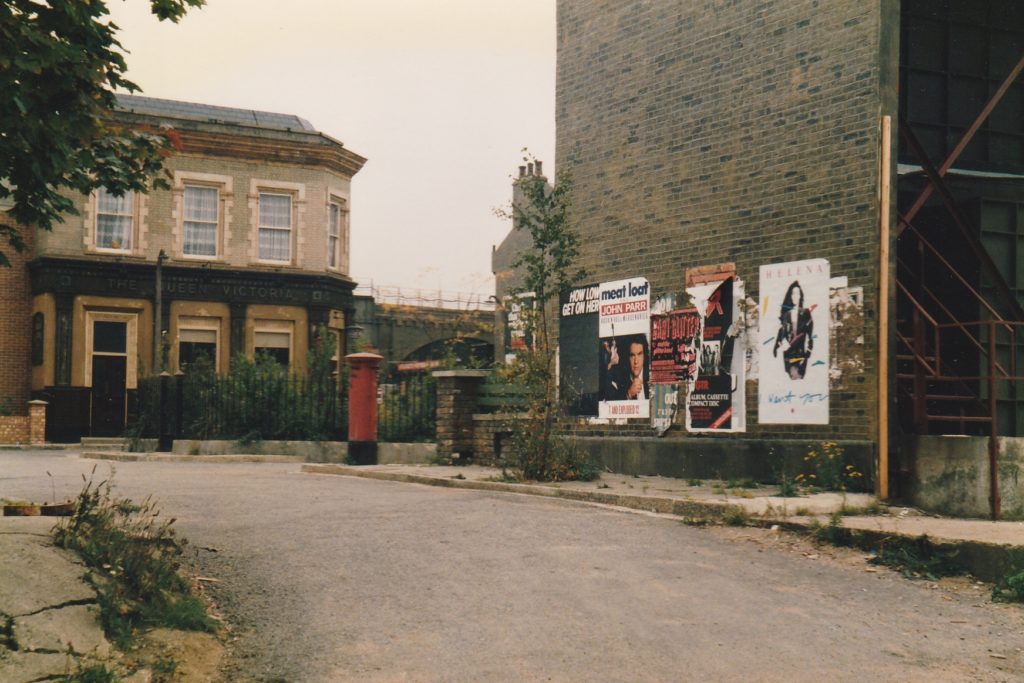
But looking at Albert Square it really is a masterpiece of construction which has stood the test of time. I’ve taken visitors round the Square on many occasions (before security was tightened).
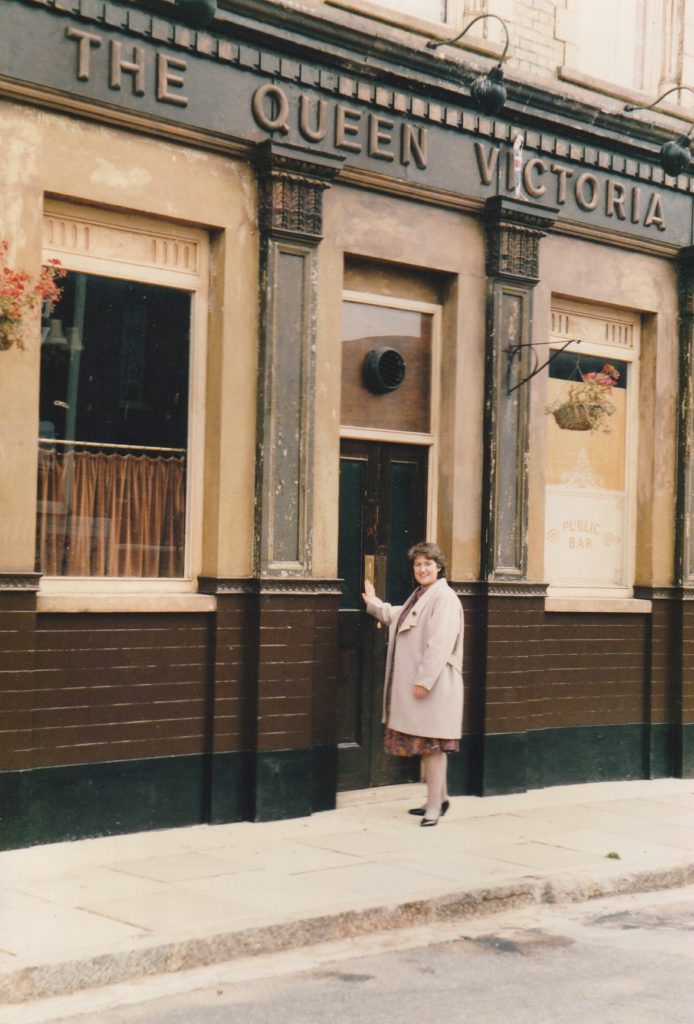
[Visitors round the square included] (in 1987) 12 would-be weather presenters, who were at Elstree to be put through their paces in Studio E by Bill Giles (Suzanne Charlton was the only woman in this group and was subsequently picked as a presenter). Their faces were pictures when they walked on to Albert Square!
Another visitor in Albert Square!
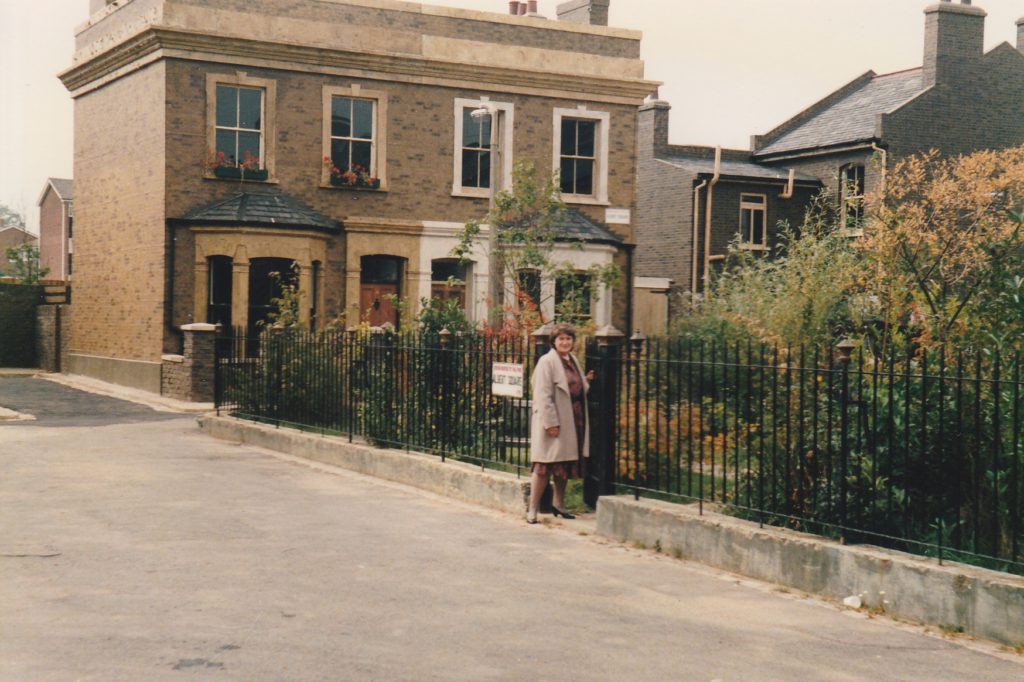
In the middle of 1987, not long after I had married, my in-laws came down from Glasgow. My wife and I took them out for the afternoon to visit the RSPCA rescue place near Potters Bar from where we had adopted a cat. On the way back through Borehamwood High Street, I turned into Elstree Centre, stopped to ask the Commissionaire (remember them) in the security building if he could turn the alarms off on Albert Square, then drove round there and stopped outside the Queen Vic!
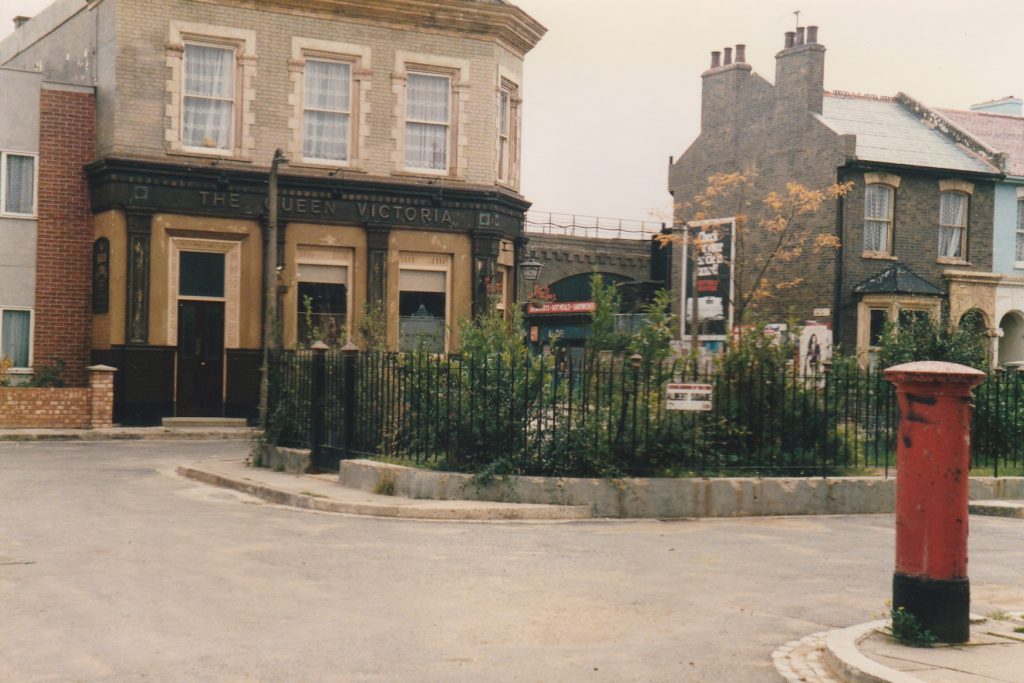
My mother-in-law’s eyes were nearly on stalks when she realized where we were! In the early days when EastEnders were only using the Lot for a couple of days a week, TVT had permission to use it for PSC training shoots. I have spent quite a number of days there and when things were quiet, I had a look round and found quite a number of interesting things, including some ‘in’ jokes. For a start the telephone boxes at the end of Bridge Street opposite the bus garage, actually work and appear to have ‘proper’ lines on them, not extensions off the Elstree switchboard. One is for coins the other takes phone cards (although this information is now dates from the mid-1980s!)
Similarly, the fish and chip shop and the Bookies had, respectively, the names of the Construction Manager and Construction Supervisor as proprietors (Mike Hagen and Ernie Turville). (The details of this paragraph appeared in an edition of ‘Prospero’ as originally I couldn’t remember Ernie’s surname, so a request for information was put out and it was found very quickly!) The back car park has also been used for outdoor sets – for the drama series ‘Bluebell’, a Paris street was built on the car park in line with Studio A/B building. Downing Street was also built in the roadway between what is now the EastEnders production area and Albert Square.
An item for ‘The Late, Late Breakfast Show’ featuring someone being shot out of a circus cannon, went out live one Saturday evening from the car park next to the rehearsal block, where the Grange Hill set was subsequently built. Apparently, this was the first time since a programme had been transmitted live since ‘The Golden Shot’.
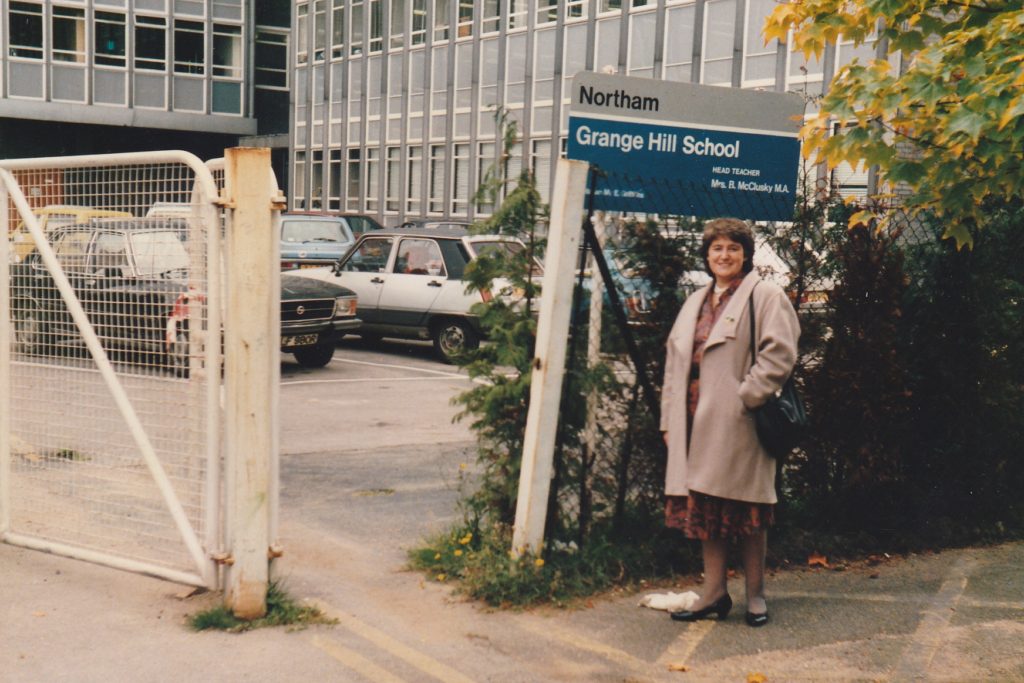
Studio A: Studio A was let out as a four-waller when the BBC first bought Elstree. I remember a Children’s Film Foundation film being made in there during early 1984. Later, the studio was home to Tripod City as part of the Tripod series. The output of the studio was sent down the line to TC for inclusion in the episodes.
Studio B: Subsequently used for Grange Hill, using an OB scanner as a production gallery.
Studio C: EastEnders standing sets. After EE moved to their new studio alongside Albert Square, Studio C housed ‘Top of the Pops’ for a few years.
Open Days
A number of Open Days have been held at the Centre, with the first couple being in early July 1984. On a Friday, a number of schools were invited to come along and look round the site. Studio C was set up with a number of exhibits and Studio D had a video showing of the history of the site. On the day after, the site was opened to local people (an advert had been placed in the local papers) and around 3000 came along. As well as the exhibits and video in Studios C and D, Special Effects Department ran a couple of demonstrations lasting about 20 minutes each, on the car park next to the Clarendon Road entrance. Their shows consisted of the ‘how to break a bottle over someone’s head – and would anyone from the audience like to try!’, firing a cannon with the resultant explosion of the shell landing, through to a Dalek (would any child like to have a go!), and K9 was also running around. In the garden area just outside the club, were a number of Triffids, plus a crocodile that had been used as prop in a number of productions.
In addition to the Dalek used by Special Effects, another one had been found (I didn’t ask where!) and was placed in the alcove at the canteen end of the long corridor. Inside was a cassette machine with an endless tape on which a number of appropriate Dalek-like comments about the open day had been recorded. The voice was that of Keith Clement who, at the time, was Head of Elstree Development (and an ex-head of TVT). I recorded the tape and borrowed the original Dalek modulator from TC to produce the final cassette (I still have the originals). It was fun to see children spy the Dalek and run up to it, then recoil somewhat when it spoke! Although there were other Open Days (at about 2 year intervals), that first open day for the locals was very appreciated as one woman, who had come with a school the previous day, thanked me for the two days and said that, in all the time ATV had been on site, they had done nothing similar.
A bit of a laugh
1. “‘Allo, ‘Allo” : My wife and I were fans of “‘Allo, ‘Allo”, so I tried to get tickets for the first show of the first series to be recorded in Studio D (January/February 1988). On ringing PBX for the number of the production office, the operator came back with the immortal line ‘Listen very carefully, I will say this only vonce!’
2. PBX calling: As already stated, a number of TVT staff were at Elstree before the official move. When we arrived on site, it was the practice to call PBX and tell the operator (Maisie or Peter) where we were on site so that calls from Woodstock Grove could be put through quickly (internal dialling to/from Elstree via TC wasn’t yet possible). One afternoon, my colleague Dick Hammett and I were leaving the site after calling in to PBX to say we were off. The PBX switchboard at that time was in a front corner room on the first floor of what is now Fairbanks. As we got to our cars which were parked in the Fairbanks car park, Dick heard his name being called – it was Maisie who was hanging out of the window of PBX telling him that there was call for him! I think this gives a whole new meaning to be paged by PBX!
3. Flying bike shed: One lunchtime, Phil Pitcher, the house manager, came rushing into my office and asked if he could borrow a Polaroid camera, as he wanted to take some instant photos of a problem in the car park just outside the ‘Grange Hill’ set (alongside the rehearsal block).
I followed Phil down and found that the bike shed (which was part of the set and normally on the inside of the fence at the front of the outdoor set and to the left of the gate going in), was now lying against the side of a car which was parked on the other side of the fence. It was a very windy day and a gust had caught the bike shed and lifted it completely over the 6-foot fence! There was a small problem – the car that it was propped up against belonged to the late Julia Smith, then producer of “EastEnders”. Julia was jumping up and down saying: ‘Get it off my car. Get it off my car!’ It was all Phil and I could do to keep straight faces!
4. Naming Fairbanks: The Fairbanks building is named after Douglas Fairbanks Junior who had a long connection with the site. He was asked to name the building and to add a bit of a swashbuckling flavour to the ceremony, Keith Clement, Head of Elstree Development, gave Douglas a rapier to lift the cloth off the name plate over the door. A photo of this event appeared in the local paper.
5. This wouldn’t happen to Wogan! During a day of ‘how to direct interviews’ in Studio E, the instructor in charge of the course made it more interesting by asking outside people in to be interviewed rather than use members of the course. Walking past the Green Room during the day, I came across the crew of a fire engine, who were having a good laugh watching the monitors. Rather jokingly I asked where their engine was and was told that they had left it in the car park! It was – in the hatched area opposite Fairbanks. It turned out that the Station Officer (probably Jack Daw – and I’m not joking), from Borehamwood fire station, was one of the people asked if he would like to be interviewed, hence the crew’s merriment in the Green Room. What was more to the point was that the crew were on call and if one came, and the Station Officer was in the middle of being interviewed, then he would have upped and left the studio very quickly! This didn’t happen, but the story did make ‘Ariel’ under a headline to the effect ‘This wouldn’t happen to Wogan’ – a reference to the series of early evening programmes that Wogan was doing at the time from the Greenwood Theatre. (TVT had a large number of locations for PSC shoots and we used Borehamwood fire station on many occasions, hence the fact that the Station Officer agreed to be interviewed. We also filmed at Croxley Green fire station and the main Herts fire brigade training department near St. Albans).
How I (indirectly) disrupted a recording of “EastEnders”
To make magazine training programmes more ‘life like’ Studio D’s red lights were manually flashed for two minutes at the start of a programme (and a presentation style video tape complete with cue dots, was run at the same time).
Doing this ‘digitally’, that is, by continually pressing the red light button, got a bit painful after a time, so I designed a timer/relay circuit which was wired across the red light switch and when started by a spare button on the sound desk, did the job automatically. Pressing the red light button at the end of two minutes cancelled the flashing and put up a steady red.
During a recording of an episode of EE one Thursday afternoon, VT at TC reported regular white flashing across the picture incoming from Elstree. On investigation, it was found that the flasher unit I had installed was causing the problem, although there was a thought that a stray cable into CTA wasn’t helping (with many cables just being hacksawed through in that area!)
The matter was sorted two ways – a note appeared on the sound desk saying that the red light flasher wasn’t to be used on days that EE were recording, and a special video amplifier was fitted in CTA between Studio C and the outgoing line to TC.
The Royal Chairs
After the visit of the Queen and Royal Party to view an episode of “The Good Life” at TC in 1976, our studio handy man (Charlie Lavery) was walking round the ring road and spotted six very plush office chairs outside a studio.
Making enquiries, he found out that they were the chairs used by the Royal Party when they were in the audience show and that they weren’t needed anymore. Always on the lookout for something for nothing, Charlie asked if TVT could have them and was told to take them away. The end result was that the chairs were used for many years in the Woodstock Studio and later at Elstree Centre. I will say that they were very hard-wearing chairs (more so considering the amount of moving around they endured in the TVT studios) and were still in use at TVT when I took early retirement in 1993.


